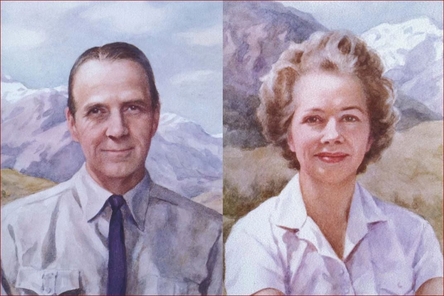 Charles and Marie Robertson's $35 million donation to Princeton in 1961 was among the most generous gifts ever made to an American university. |
IN LIEU of a present, the bat mitzvah invitation from my niece suggested donating money to help feed the poor. It recommended one charity in particular, an organization that describes itself as "a Jewish response to hunger" and promises to allocate its money to "the most effective hunger relief organizations" in the United States and abroad.
I admired my niece's selfless spirit, and was glad to make a donation in her honor; I followed it up with a second donation a few months later. Then I discovered that a lot of this charity's money goes not to food banks and meals-on-wheels, but to lawyers and lobbyists with a political agenda that includes enrolling more people on food stamps and other government programs. Expanding welfare dependency may be some people's idea of "effective hunger relief," but it isn't mine. So I crossed this organization off my list of charities to support.
Of course, I had only myself to blame for not doing my homework before writing a check. Like most donors, I tend to rely more on trust and instinct than on research when it comes to charitable giving. I am also like most donors in making unrestricted gifts — my modest donations have no strings attached, and the recipients can spend them as they see fit.
But what happens when a donation does come with strings attached and the recipient doesn't respect them? That's the issue at the heart of a number of conflicts that have jolted the philanthropic world.
Earlier this year, for example, Jane Fonda revoked the $12.5 million pledge she had made to Harvard; she was reportedly frustrated with the university's slowness in setting up the gender-studies institute her money was intended to endow. Across the Charles River, Boston University agreed to disgorge the $3 million that alumnus David Mugar had donated in 1988 for the renovation of a library named after his grandparents. The renovation never took place, and Mugar had threatened a lawsuit.
In New York, Adele Smithers has taken St. Luke's-Roosevelt Hospital to court, claiming that it used her late husband's $10 million gift for purposes other than the one he specified: an innovative form of alcoholism treatment. The heirs of pharmaceutical magnate John Searle are battling the Chicago Community Trust over control of a $280 million charitable fund he created. The family contends that Searle's will is being flouted, and they want to yank control of the fund away from the trust.
The biggest and most important of these disputes is unfolding in a courtroom in New Jersey. At stake are more than half a billion dollars — and the future of one of the nation's foremost graduate schools of public affairs.
The story begins in 1961, when Charles and Marie Robertson donated $35 million to set up a charitable foundation at Princeton University. The creation of the Robertson Foundation may be the most generous gift in the history of American higher education: Its endowment is now worth almost $600 million, over and above the $200 million that Princeton has already spent.
The Robertsons made their gift for an explicit purpose: "to strengthen the government of the United States and increase its ability and determination to defend and extend freedom throughout the world." To that end, the foundation was directed to "maintain and operate at Princeton University, and as part of the Woodrow Wilson School, a graduate school where men and women dedicated to public service may prepare themselves for careers in government . . . with particular emphasis on . . . those areas of the federal government that are concerned with international relations."
But despite the donors' clear intent, few of the Wilson School graduates actually go on to foreign-affairs-related government jobs. University statistics show that Only 200 of the 1,720 students who earned MPA (Master of Public Administration) degrees between 1973 and 2002 took such positions after graduating. "Year after year," the Washington Post observes, "the school has churned out bright young men and women who go to work in nonprofit agencies and universities and private industry -- just about anywhere but the federal government."
The Robertson family has long chafed at this failure to live up to the foundation's mission. As far back as 1970, Charles Robertson wrote to complain about the "disappointing number of MPA degree holders in public service, particularly in the international agencies." For its part, Princeton argues that times have changed, that government service no longer holds the appeal it once did, and that "public service" is too broad a category to be restricted to government employment. In any case, the university says in its court filings, "alleged expressions of donative intent are legally insignificant."
They certainly aren't insignificant to donors — and in this country, that means most of us. Americans donated $241 billion to charity last year, a level of private generosity unknown anywhere else. Very few of us will ever be able to match the munificence of Charles and Marie Robertson. But it isn't only multimillionaires who have the right to expect that money donated for a specific purpose will be used for that purpose. It's sad to see one of the greatest acts of philanthropy in US history become the subject of bitter litigation. But it would be sadder by far if donors came to believe that their intentions count for nothing.
(Jeff Jacoby is a columnist for The Boston Globe).
-- ## --
Follow Jeff Jacoby on Twitter.
Discuss his columns on Facebook.
Want to read more? Sign up for "Arguable," Jeff Jacoby's free weekly email newsletter.

